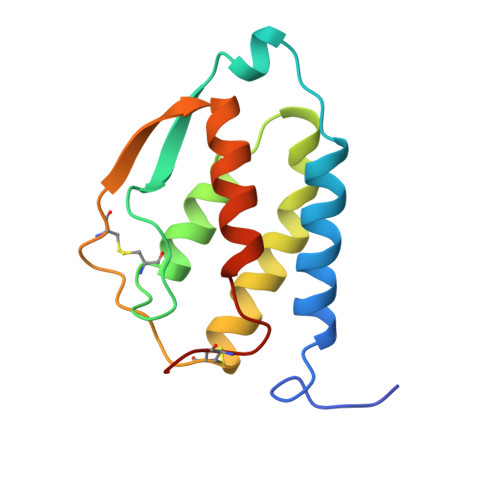Refined crystal structure and mutagenesis of human granulocyte-macrophage colony-stimulating factor.
Rozwarski, D.A., Diederichs, K., Hecht, R., Boone, T., Karplus, P.A.(1996) Proteins 26: 304-313
- PubMed: 8953651
- DOI: https://doi.org/10.1002/(SICI)1097-0134(199611)26:3<304::AID-PROT6>3.0.CO;2-D
- Primary Citation of Related Structures:
2GMF - PubMed Abstract:
The crystal structure of recombinant human granulocyte-macrophage colony stimulating factor (rhGM-CSF) has been refined against data extending to a resolution of approximately 2.4 A along a* and approximately 1.9 A along b* and c*. Anisotropic scale factors of B11 = -20.8 A2, B22 = 7.4 A2, B33 = 13.3 A2 corrected for the more rapid fall of diffraction in the a* direction. The anisotropy correlates with the weak crystal packing interactions along the a axis. In addition to apolar side chains in the protein core, there are 10 buried hydrogen bonding residues. Those residues involved in intramolecular hydrogen bonding to main chain atoms are better conserved than those hydrogen bonding to other side chain atoms; 24 solvation sites are observed at equivalent positions in the two molecules in the asymmetric unit, and the strongest among these are located in clefts between secondary structural elements. No buried water sites are seen. Two surface clusters of hydrophobic side chains are located near the expected receptor binding regions. Mutagenesis of 11 residues on the helix A/helix C face confirms the importance of Glu-21 and shows that Gly-75 and Gln-86, located on helix C, each cause a greater than fourfold drop in activity. Glu-21 and Gly-75, but not Gln-86, are structurally equivalent to residues involved in the growth hormone binding to its receptor.
- Section of Biochemistry, Cornell University, Ithaca New York 14853, USA.
Organizational Affiliation:
















